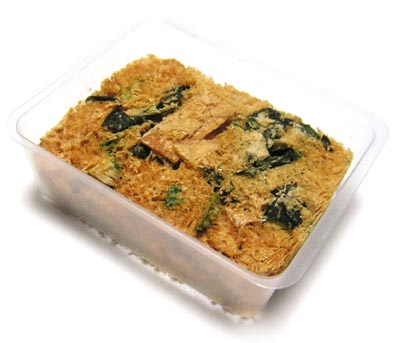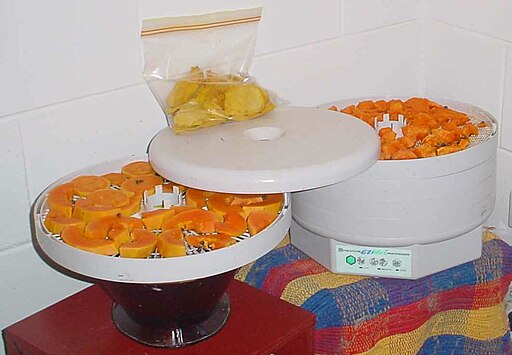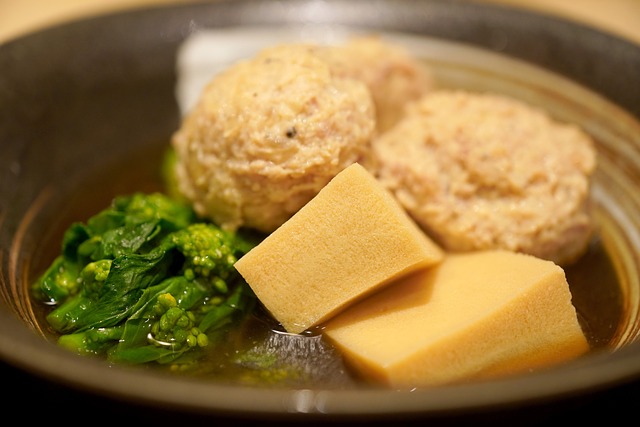Freeze-drying preserves food by freezing and removing moisture, while dehydration uses heat to remove moisture for preservation.
Freeze Dried Vs. Dehydrated
Freeze Drying refers to the process of removing moisture from food through freezing and then sublimation. This involves freezing the food to a very low temperature and then slowly removing the ice crystals by using a low-pressure environment. This method helps in preserving the nutritional value, flavor, and texture of the food.
Dehydration, on the other hand, is the process of removing moisture from food by using heat. The food is typically heated at a low temperature for a prolonged period, which draws out the moisture and inhibits the growth of bacteria and molds. Dehydration helps in preserving the food’s shelf life while maintaining its nutritional content.
What is Freeze Drying?

Freeze drying is a preservation method that involves removing moisture from a product while it is frozen. It is a process that is commonly used in the food industry to extend the shelf life of various food items. Here is an overview of how freeze drying works:
1. Freezing: The product to be freeze dried is first frozen at very low temperatures. This freezing process helps to retain the product’s structure and prevents the formation of ice crystals.
2. Primary Drying: Once the product is frozen, it is placed in a vacuum chamber. The pressure in the chamber is reduced, and heat is applied. This causes the frozen water in the product to sublimate directly from solid to gas without passing through the liquid phase. This step is called primary drying.
3. Secondary Drying: After the majority of the moisture has been removed through sublimation, the product undergoes secondary drying. In this step, the temperature is raised slightly, and any remaining moisture is removed through evaporation.
4. Sealing: Once the freeze drying process is complete, the product is sealed in a moisture-proof packaging to prevent rehydration.
Freeze drying preserves the product by removing water content, which inhibits the growth of microorganisms and enzymatic reactions that can cause spoilage. It also helps to retain the product’s flavor, texture, and nutritional value.
How Does Freeze Drying Work?
Freeze drying, also known as lyophilization, is a fascinating process used to remove moisture from a product while maintaining its texture and nutritional value. But how does freeze drying work?
In this method, the product is first frozen and then placed in a special vacuum chamber. Inside the chamber, a process called sublimation occurs, where the frozen water in the product directly converts into vapor without transitioning through the liquid state.
To safeguard the product’s integrity, freeze drying subjects it to low temperatures and low pressure. This unique combination allows the water to evaporate without causing any damage to its structure. Through sublimation, the frozen moisture transforms into vapor and is ultimately removed from the chamber, resulting in a freeze-dried product.
Now, let’s explore the advantages of freeze drying. One significant benefit is that it preserves the product’s texture, appearance, and original qualities. Unlike other drying methods like air drying or dehydration, freeze drying allows the product to maintain its shape, color, and texture.
Furthermore, freeze drying effectively retains the nutritional value of the product. The low temperatures utilized in the process minimize the degradation of sensitive nutrients, vitamins, and enzymes. This aspect makes freeze-dried products an excellent choice for those seeking to incorporate healthy ingredients into their diet.
Apart from food, freeze drying is a highly efficient technique widely employed in preserving various products, including pharmaceuticals. It provides extended shelf life, minimal nutrient loss, and preserved quality. By understanding how freeze drying works, individuals can make informed decisions when considering freeze-dried products to meet their specific requirements.
Freeze drying is a remarkable process that involves removing moisture from a product without compromising its texture and nutritional composition. Now that you know how freeze drying works, you can appreciate the benefits it offers and make well-informed choices regarding freeze-dried products.
What Are the Benefits of Freeze Drying?
Freeze drying offers numerous benefits that make it a popular method of food preservation. Here are some of the key advantages of freeze drying:
- Preservation of Nutritional Value: Freeze drying helps retain the nutritional content of food by preserving vitamins, minerals, and enzymes. The process involves freezing the food at low temperatures and then removing the water through sublimation, without subjecting it to high heat that can degrade nutrients.
- Enhanced Shelf Life: Freeze-dried foods have a significantly longer shelf life compared to fresh or dehydrated foods. The removal of moisture inhibits the growth of bacteria, yeast, and mold that cause food spoilage. Properly stored, freeze-dried foods can last for years, ensuring food availability during emergencies or extended periods of time.
- Retained Taste and Texture: Freeze drying helps maintain the original taste, texture, and appearance of the food. The freeze-drying process results in lightweight, crispy food that retains its natural flavors. Rehydrating freeze-dried food restores it to its original state, making it enjoyable to eat.
- Quick Rehydration: Freeze-dried foods rehydrate quickly when water is added. This makes them convenient for outdoor activities, camping trips, or situations where quick and easy meal preparation is essential.
Considering these benefits, freeze drying is an excellent choice for preserving food while maintaining its nutritional value, taste, and texture. Whether you are an outdoor enthusiast, preparing for emergencies, or simply looking for convenient and long-lasting food options, freeze-dried products can be a valuable addition to your pantry.
What is Dehydration?

Dehydration is a process that involves removing moisture from food or other substances to extend their shelf life. It is a common preservation technique that has been used for centuries. Here is an overview of how dehydration works:
1. Moisture Removal: Dehydration involves removing the water content from the food or substance. This is typically done by exposing the material to low heat, circulating air, or a combination of both. The heat and airflow help evaporate the moisture, leaving behind the dehydrated product.
2. Preservation: By removing water, dehydration inhibits the growth of microorganisms such as bacteria, yeast, and mold. These microorganisms require moisture to survive and thrive, so reducing the water content helps prevent spoilage and extends the shelf life of the product.
3. Nutrient Retention: Dehydration preserves the nutritional value of the food to a great extent. While there may be some loss of certain heat-sensitive vitamins and enzymes during the drying process, dehydration generally retains the essential nutrients, including carbohydrates, proteins, and minerals.
4. Concentration of Flavor: Dehydration intensifies the flavors of the food by reducing its water content. As the moisture evaporates, the flavors become more concentrated, resulting in a more robust taste.
5. Lightweight and Portable: Dehydrated foods are lightweight and have a reduced volume compared to their fresh counterparts. This makes them highly convenient for various applications, including camping, backpacking, and emergency food supplies.
6. Rehydration: Dehydrated foods can be rehydrated by adding water or other liquids. This process allows the food to regain its original texture and appearance, making it suitable for consumption.
Dehydration is a preservation method that removes water from food or substances to prevent spoilage, retain nutrients, concentrate flavors, and provide a lightweight and portable product.
How Does Dehydration Work?
During dehydration, the moisture content of the food is reduced to a level where bacteria, yeast, and mold cannot grow, preventing spoilage. By removing moisture, dehydration also inhibits the enzymatic reactions that lead to the degradation of the food’s quality and nutritional value.
The process of dehydration works by using controlled heat and airflow to gradually remove the water from the food. The food is thinly sliced or diced to increase the surface area for moisture to be released. The heat and airflow remove the moisture, which escapes through vents in the dehydrator. The duration of dehydration depends on various factors such as the type and size of food, humidity levels, and the dehydrator’s settings.
Dehydration offers several benefits. It significantly prolongs the shelf life of food, making it ideal for long-term storage and emergency preparedness. Dehydrated food is lightweight and compact, making it convenient for camping, hiking, and other outdoor activities. It also retains a high nutritional value, as most vitamins and minerals are not affected by the dehydration process.
Fact: Dehydration can reduce the moisture content of food by as much as 95%, resulting in a lightweight and concentrated source of nutrients.
What Are the Benefits of Dehydration?
- Longer shelf life: Dehydration significantly extends the shelf life of food by removing moisture, preventing the growth of bacteria, yeasts, and molds.
- Preservation of nutrients: Dehydration preserves the nutritional content of fruits, vegetables, and meats better than other preservation methods.
- Portability and convenience: Dehydrated foods are lightweight and compact, making them easy to carry and store. They are ideal for camping, hiking, and other outdoor activities.
- Reduced waste: Dehydration allows you to preserve excess fruits, vegetables, and herbs before they spoil, reducing food waste.
- Enhanced flavor: Dehydration concentrates the flavors of foods, resulting in more intense and delicious flavors compared to fresh produce.
- Cost-effective: Dehydrating your own foods at home can save you money, as dehydrated foods are often more expensive to purchase.
- Snack versatility: Dehydrated fruits and vegetables can be enjoyed as healthy, portable snacks or used as ingredients in recipes.
- Minimal use of additives: Dehydration requires little to no preservatives or additives, allowing you to enjoy natural, chemical-free foods.
Incorporating dehydrated foods into your diet offers a range of benefits, including longer shelf life, preserved nutrients, enhanced flavor, and cost-effectiveness. Dehydrated foods are convenient, portable, and versatile, making them a great option for those who enjoy outdoor activities or want to reduce food waste. Try dehydrating your favorite fruits, vegetables, and meats at home to enjoy the many benefits of dehydration.
Comparison between Freeze Drying and Dehydration
When it comes to preserving food, there are two popular methods that reign supreme: freeze drying and dehydration. In this comparison, we dive into the nitty-gritty details of these two techniques. From the preservation of nutritional value to the texture and appearance of the final product, we’ll unravel the differences. Plus, we’ll explore the impact of shelf life and rehydration time. Get ready to discover which method suits your food preservation needs like a pro!
Preservation of Nutritional Value
The preservation of nutritional value is an important factor to consider when choosing between freeze drying and dehydration methods.
To understand the difference in preserving nutritional value, let’s compare the two methods using a table:
| Method | Preservation of Nutritional Value |
| Freeze Drying | Freeze drying preserves the nutritional value of food exceptionally well. During the freeze drying process, the food is frozen and then dried under a vacuum, which removes the majority of the water content while retaining the food’s nutrients. This method helps to preserve the original taste, color, texture, and nutritional content of the food. It has been found that freeze-dried foods can retain up to 98% of their nutritional value. |
| Dehydration | Dehydration also preserves some of the nutritional value of food. In the dehydration process, the food is heated to remove the water content. The high heat used in dehydration can cause some loss of heat-sensitive vitamins and minerals. The dehydration process can affect the taste, color, and texture of the food. While dehydration does preserve some nutrients, it may lead to a higher loss compared to freeze drying. |
From the comparison, it is clear that freeze drying is superior in preserving the nutritional value of food. It retains a higher percentage of nutrients compared to dehydration. If maintaining the nutritional content of food is a priority, then choosing freeze drying would be a better option. It’s important to note that both methods can still provide nutritious food options, but freeze drying offers a higher level of preservation.
Texture and Appearance
The texture and appearance of freeze-dried and dehydrated products can vary significantly. Here is a comparison of the two methods:
| Texture | Freeze Drying | Dehydration |
| Soft and Porous | The freeze-drying process results in a delicate texture that is airy and porous. | Dehydrated products tend to have a firm and chewy texture. |
| Retains Original Structure | Freeze-drying preserves the original structure and shape of the food, maintaining its integrity. | Dehydration can cause some shrinkage and loss of structure, resulting in a different appearance. |
| Rehydration | When rehydrated, freeze-dried products regain their original texture, appearing almost identical to their fresh counterparts. | Dehydrated products may require soaking or cooking to regain a semblance of their original texture. |
Freeze-drying creates a soft and porous texture while maintaining the original structure of the food. On the other hand, dehydration results in a firmer texture with some loss of structure. When rehydrated, freeze-dried products regain their original texture, while dehydrated products may require additional steps for texture restoration. Consider your desired texture and appearance when choosing between freeze-dried and dehydrated products.
Shelf Life
The shelf life of freeze-dried and dehydrated products depends on various factors, including the type of product and the storage conditions.
To compare the shelf life of freeze-dried and dehydrated products, we can create a table:
| Factor | Freeze-dried | Dehydrated |
| Shelf Life | Up to 25 years | Up to 15 years |
| Storage Conditions | Low humidity and temperature | Dry and cool location |
| Quality | Retains original flavor, texture, and nutritional value | May experience slight changes in flavor, texture, and nutrition |
| Risk of spoilage | Less susceptible to moisture and bacteria | More susceptible to moisture and bacteria |
| Rehydration | Quick to rehydrate | Takes longer to rehydrate |
As seen in the table, freeze-dried products have a longer shelf life of up to 25 years compared to dehydrated products, which have a shelf life of up to 15 years. Freeze-dried products should be stored in low humidity and temperature conditions, while dehydrated products require a dry and cool location.
Freeze-dried products also have better quality retention, maintaining their original flavor, texture, and nutritional value. On the other hand, dehydrated products may undergo slight changes in flavor, texture, and nutrition over time.
In terms of spoilage risk, freeze-dried products are less susceptible to moisture and bacteria compared to dehydrated products. Both methods require proper storage to prevent spoilage.
When it comes to rehydration, freeze-dried products rehydrate quickly, while dehydrated products take longer. This is an important consideration depending on how quickly you need to use the product.
If you prioritize a longer shelf life, better quality retention, and quick rehydration, freeze-dried products would be the ideal choice. If a slightly shorter shelf life and slight changes in flavor and texture are acceptable, dehydrated products can also be a suitable option.
Rehydration Time
Rehydration time is an important factor to consider when comparing freeze drying and dehydration methods. A table can be created to highlight the differences in rehydration time between the two methods.
| Method | Rehydration Time |
| Freeze Drying | Shorter rehydration time |
| Dehydration | Longer rehydration time |
With freeze drying, the rehydration time is shorter compared to dehydration. This is because freeze drying removes the water content from the food or product before rehydration, allowing for quicker absorption of liquid during the rehydration process. Dehydration, on the other hand, retains some moisture in the food, resulting in a longer rehydration time as the product absorbs the liquid at a slower rate.
The exact rehydration time may vary depending on the specific food or product being processed, as well as the conditions in which rehydration takes place. In general, freeze-dried products can rehydrate faster compared to dehydrated products.
When considering which method to choose, it is important to take into account the desired rehydration time, as well as other factors such as preservation of nutritional value, texture and appearance, and shelf life. Ultimately, the choice between freeze drying and dehydration will depend on the specific needs and requirements of the product or application.
Which Method Should You Choose?
When deciding between freeze-dried and dehydrated methods, consider the following factors to determine which is best for your needs:
- Nutritional Content: If preserving the nutritional content of the food is important to you, freeze-drying is the better option. Freeze-dried foods retain more nutrients compared to dehydrated foods.
- Texture and Taste: Freeze-dried foods often maintain a better texture and taste after rehydration compared to dehydrated foods. If texture and taste are crucial to your preference, freeze-dried might be the preferred choice.
- Rehydration Time: Dehydrated foods typically rehydrate faster than freeze-dried foods. If you require quick and convenient rehydration, dehydrated foods may be more suitable.
- Shelf Life: Freeze-dried foods have a longer shelf life compared to dehydrated foods. If long-term storage without compromising quality is important, freeze-dried products are a better option.
- Weight and Volume: Freeze-dried foods are generally lighter and occupy less space compared to dehydrated foods. If you need lightweight and compact food for camping, backpacking, or traveling, freeze-dried options are more convenient.
- Cost: Dehydrated foods are often more affordable than freeze-dried alternatives. If budget is a significant consideration, dehydrated products may be the more cost-effective choice.
Consider your specific needs, priorities, and intended use of the food to determine whether freeze-dried or dehydrated is the most suitable method for you.
Frequently Asked Questions
What’s the difference between freeze-dried and dehydrated food?
Freeze-dried and dehydrated food refer to different processes for drying food. Dehydrated food has had 90-95% of the moisture removed, while freeze-dried food has a higher percentage, usually around 98-99%. Freeze drying is a more complex process that requires specialized equipment, involving freezing the food at extremely low temperatures and then subjecting it to a vacuum to remove the frozen water.
What are the benefits of dehydrating food?
Dehydrating food allows you to preserve it for longer periods and cut down on food wastage. It’s a relatively old method that has evolved over time, and it can be done at home using affordable dehydrators. Dehydrating also allows you to make your own herbs and garnishes.
What are the benefits of freeze drying food?
Freeze drying is a newer method of food preservation that has gained popularity in recent years. It retains a high nutritional profile and has a longer shelf life compared to dehydrated food, thanks to its lower moisture content. Freeze drying is commonly used for preserving specific foods like coffee. However, it requires specialized equipment and is more suitable for commercial kitchens.
Is freeze-dried food healthier than dehydrated food?
Both freeze-dried and dehydrated food retain a high nutritional profile. While freeze-dried food may have a slight advantage in terms of preserving nutrients due to its lower moisture content, the difference in nutritional value between the two methods is generally minimal. So, in terms of health, both freeze-dried and dehydrated food can be considered healthy options.
Can I make freeze-dried or dehydrated food at home?
Dehydrating food can be easily done at home using affordable dehydrators. It involves using trays and fans to dry the food at temperatures ranging from 95°F to 165°F until 95% or more of the moisture is removed. On the other hand, freeze drying requires specialized equipment and is more suitable for commercial kitchens. However, with the availability of home freeze dryers, it is now possible to freeze dry food at home, but it requires a larger and heavier machine.
What are the differences in the preservation process between freeze drying and dehydrating?
Dehydrating involves removing moisture from the food using warm blowing air or sun drying. The process can be relatively quick, depending on the type of food and the chosen method. On the other hand, freeze drying is a more complex process that involves freezing the food at negative temperatures and then sublimating the frozen water under a vacuum. This process takes longer and requires specialized equipment.
Image Credits
Featured Image By – takedahrs from Pixabay
Image 1 By – Gleam at Japanese Wikipedia, CC BY-SA 3.0 , via Wikimedia Commons
Image 2 By – Vassilik, CC BY-SA 3.0 , via Wikimedia Commons









